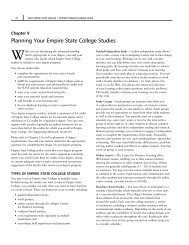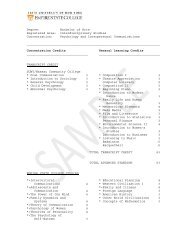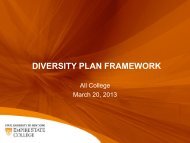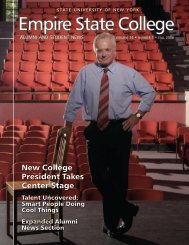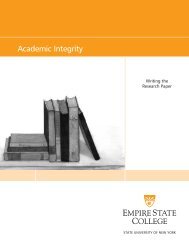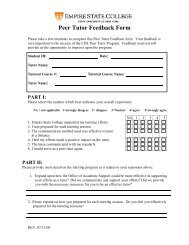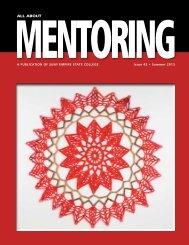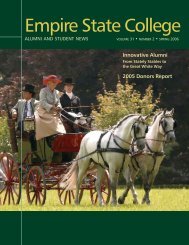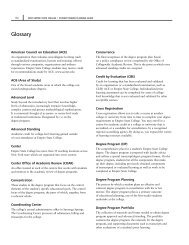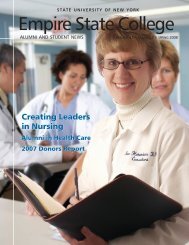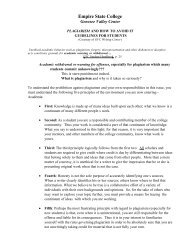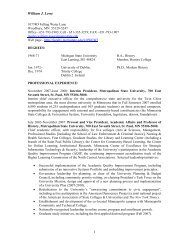Academic Plan 2011-2015 (PDF 524kB) - SUNY Empire State College
Academic Plan 2011-2015 (PDF 524kB) - SUNY Empire State College
Academic Plan 2011-2015 (PDF 524kB) - SUNY Empire State College
You also want an ePaper? Increase the reach of your titles
YUMPU automatically turns print PDFs into web optimized ePapers that Google loves.
<strong>SUNY</strong> <strong>Empire</strong> <strong>State</strong> <strong>College</strong>: <strong>Academic</strong> <strong>Plan</strong> <strong>2011</strong> - <strong>2015</strong> 13We posit that it is important to consider three issues as these criteria are reviewed. First, the criteriashould be viewed as interdependent. For example, enhanced interdisciplinary approaches to programdevelopment will, by definition, facilitate increased exposure to learning opportunities for students;at the same time, a more interconnected collegial environment facilitates greater opportunities forfaculty professional development. Similarly, as the college focuses on growth areas, our capacity willstrengthen for attracting students and preparing them for meaningful transitions to further educationor career growth.Second, it is not expected that every proposal will satisfy all six criteria or satisfy them in the same wayor satisfy them equally. Not all six need to be substantially present to sanction or certify an academicarea as one which merits support. On the other hand, as it is the intent of the academic plan to chart astrategic direction for the college’s academic future, the more a proposed academic area fulfills thesecriteria, the greater the likelihood it will be endorsed by the college.Third, the manner in which the six criteria are presented is not intended to be reflective of a hierarchyof importance. Particular criteria may emerge as vital measures of one new program’s value while othercriteria may serve such a role for another program.The following section is a discussion of the six proposed criteria.Criterion 1: Advances or is consistent with the college’s mission and core valuesIn determining how we select specific areas of academic programs on which to focus, we are advised torededicate ourselves to the core values of our institution. These historic commitments are embedded inevery facet of what we do, and help to carry on the tradition of innovation, access and experimentationwhich has defined the college’s mission since its inception. The core values of the college are at theforefront of criteria for the selection of curricular areas that receive attention. This is not simply toretain tradition for tradition’s sake, but rather to carry forward into the future that which we mostcherish. It is, thus, a retrospective as well as a prospective process, reflecting on who we have been andwhat we have cared about, how we represent ourselves to the larger academic universe, and imagininghow that identity can be preserved and extended through the promotion of particular academic areas.Examples of criteria we might deploy as a means of realizing our core values include those which:• Evaluate potential academic programs for their capacity to respond to students’ needs to bothobtain a degree that offers them marketable skills as well as a strong liberal arts background;• Allow for collaborative and innovative approaches to learning between students and mentors, aswell as student-to-student;• Recognize that there are a wide variety of learning styles which need to be fostered andsupported;• Understand that learning takes place in a variety of contexts, communities and environments, aswell as more traditional academic settings, and offers multiple opportunities to do so; and• Respond to the needs of a diverse student body and actively encourages that diversity throughoutreach and recruitment.




